Related Research Articles
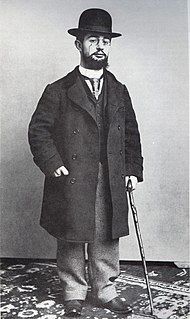
Henri Marie Raymond de Toulouse-Lautrec-Monfa was a French painter, printmaker, draughtsman, caricaturist and illustrator whose immersion in the colorful and theatrical life of Paris in the late 19th century allowed him to produce a collection of enticing, elegant, and provocative images of the modern, sometimes decadent, affairs of those times.

George Inness was a prominent American landscape painter.

Haing Somnang Ngor was a Cambodian American gynecologist, obstetrician, actor and author. He is best remembered for winning the Academy Award for Best Supporting Actor in 1985 for his debut performance in the film The Killing Fields (1984), in which he portrayed Cambodian journalist and refugee Dith Pran. He was murdered in a robbery outside his home in Los Angeles in 1996.

Reamker is a Cambodian epic poem, based on the Sanskrit's Ramayana epic. The name means "Glory of Rama".It is the national epic of Cambodia. The earliest mention of this epic's manuscript in Cambodia dated back in 7th century based on Veal Kantel inscription (K.359). While, the surviving text of Reamker dates from 16th century. Reamker adapts the Hindu ideas to Buddhist themes and shows the balance of good and evil in the world. More than just a reordering of the epic tale, the Reamker is a mainstay of the royal ballet's repertoire. Like the Ramayana, it is a philosophical allegory, exploring the ideals of justice and fidelity as embodied by the protagonists, King Rama and Queen Sita. The epic is well known among the Khmer people for its portrayal in Khmer dance theatre, called the L'khaon, in various festivals across Cambodia. Scenes from the Reamker are painted on the walls of the Royal Palace in Khmer style, and its predecessor is carved into the walls of the Angkor Wat and Banteay Srei temples. It is considered an integral part of Cambodian culture.
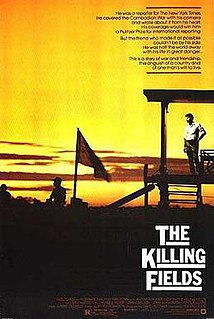
The Killing Fields is a 1984 British biographical drama film about the Khmer Rouge regime in Cambodia, which is based on the experiences of two journalists: Cambodian Dith Pran and American Sydney Schanberg. It was directed by Roland Joffé and produced by David Puttnam for his company Goldcrest Films. Sam Waterston stars as Schanberg, Haing S. Ngor as Pran, Julian Sands as Jon Swain, and John Malkovich as Al Rockoff. The adaptation for the screen was written by Bruce Robinson; the musical score was written by Mike Oldfield and orchestrated by David Bedford.

The Killing Fields are a number of sites in Cambodia where collectively more than a million people were killed and buried by the Khmer Rouge regime during its rule of the country from 1975 to 1979, immediately after the end of the Cambodian Civil War (1970–1975). The mass killings are widely regarded as part of a broad state-sponsored genocide.

The history of Asian art includes a vast range of arts from various cultures, regions and religions across the continent of Asia. The major regions of Asia include Central, East, South, Southeast, and West Asia.
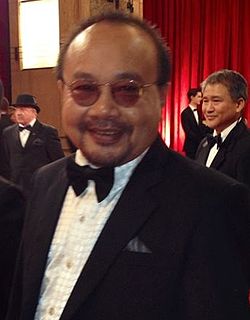
Rithy Panh is a Cambodian documentary film director and screenwriter.

The history of Cambodian art stretches back centuries to ancient times, but the most famous period is undoubtedly the Khmer art of the Khmer Empire (802–1431), especially in the area around Angkor and the mainly 12th-century temple-complex of Angkor Wat, initially Hindu and subsequently Buddhist. After the collapse of the empire these and other sites were abandoned and overgrown, allowing much of the era's stone carving and architecture to survive to the present day. Traditional Cambodian arts and crafts include textiles, non-textile weaving, silversmithing, stone carving, lacquerware, ceramics, wat murals, and kite-making.

Al Rockoff is an American photojournalist made famous by his coverage of the Vietnam War and of the Khmer Rouge takeover of Phnom Penh, Cambodia's capital. He was portrayed in the Academy Award-winning film The Killing Fields by actor John Malkovich, although he has never been happy with this portrayal. Rockoff was born in Pawtucket, Rhode Island and is of half Russian and half Irish ancestry. After enlisting in the Navy while under age, he subsequently became an Army photographer in South Vietnam.
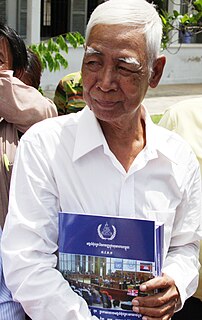
Vann Nath was a Cambodian painter, artist, writer, and human rights activist. He was the eighth Cambodian to win the Lillian Hellman/Hammett Award since 1995. He was one of only seven known adult survivors of S-21 camp, where 20,000 Cambodians were tortured and executed during the Khmer Rouge regime.

Cambodia has increasingly become involved in sports over the last 30 years.

John Malloy AKA FLuX is an American fine artist, illustrator, designer, and sequential artist. His illustrations and designs have appeared in advertising, packaging, magazines, cd covers, apparel, on the web, and in posters, with clients ranging from Peace Tea to Diesel to Business Week. His fine art employs a variety of media, including pen & ink, oil & acrylic paint, and digital.
Zhi Lin is a Chinese American mixed-media artist, a native of Nanjing, China. While he was a graduate fellow at the University College London's Slade School in 1989, the political events and social movements around the world convinced him to use his artwork for social, history and cultural awareness, and “to engage political and social reforms in our society.” Since that time his work has been a visual examination of the patterns of violence, intolerance, injustice, and complicity in public behavior."
Sa Kaeo Refugee Camp was the first organized refugee relief camp established on the Thai-Cambodian border. It was built by the Royal Thai Government with support from international relief agencies including the United Nations. It opened in October 1979 and closed in early-July 1980. At its peak the population exceeded 30,000 refugees; no formal census was ever conducted.
Nhek Dim was a Cambodian artist, painter, writer and composer.

Cambodian genocide denial was the belief expressed by many Western academics that claims of atrocities by the Khmer Rouge government (1975–1979) in Cambodia were much exaggerated. Many scholars of Cambodia and intellectuals opposed to the U.S. involvement in the Vietnam War denied or minimized the human rights abuses of the Khmer Rouge, characterizing contrary reports as "tales told by refugees" and U.S. propaganda. They viewed the assumption of power by the communist Khmer Rouge as a positive development for the people of Cambodia who had been severely impacted by the Vietnam War and the Cambodian Civil War.
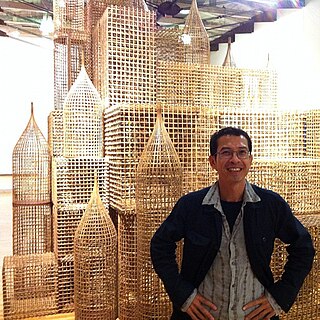
Sopheap Pich is a Cambodian American contemporary artist. His sculptures utilize traditional Cambodian materials, which reflect the history of the nation and the artist's relation to his identity.
Linda Saphan is a Cambodian artist and social anthropologist. Born in Phnom Penh, she grew up in Canada and graduated in France. She has supported women artists from Cambodia, co-organizing the first Visual Arts Open festival celebrating Cambodian artists in 2005. Her recent art work had included textiles and embroidery. As an academic, she is currently Assistant Professor of Sociology at Paris Nanterre University.
You Khin was a Cambodian architect and artist. He graduated from the Royal University of Fine Arts in 1973, and left Cambodia prior to the Khmer Rouge evacuation of Phnom Penh. Over the next two decades, he practised architecture in France, Sudan, Qatar and the United Kingdom. You Khin returned to Cambodia in 2003 with his wife Muoy where they founded a Montessori school for disadvantaged children and a guesthouse to help support it. His mixed media paintings are of the impressionist style and have been exhibited in the US, Sudan, the UK and Cambodia. The You Khin Memorial Women’s Art Prize was established by the United States Embassy in Cambodia and JavaArts
References
- ↑ Bayor, Ronald H. (July 22, 2011). Multicultural America: An Encyclopedia of the Newest Americans (4 volumes): An Encyclopedia of the Newest Americans. ABC-CLIO. p. 223. ISBN 978-0-313-35787-9.
- ↑ "Art and Culture Program". SIDO. Retrieved September 28, 2014.CS1 maint: discouraged parameter (link)
- ↑ "Rain Falls from Earth: Surviving Cambodia's Darkest Hour". Sms.cz. Retrieved September 28, 2014.CS1 maint: discouraged parameter (link)
- 1 2 "Monirith Chhea". Mekong.net. Retrieved September 28, 2014.CS1 maint: discouraged parameter (link)
- ↑ Art Now Gallery Guide: International. Art Now, Inc. January 1994. p. 42.